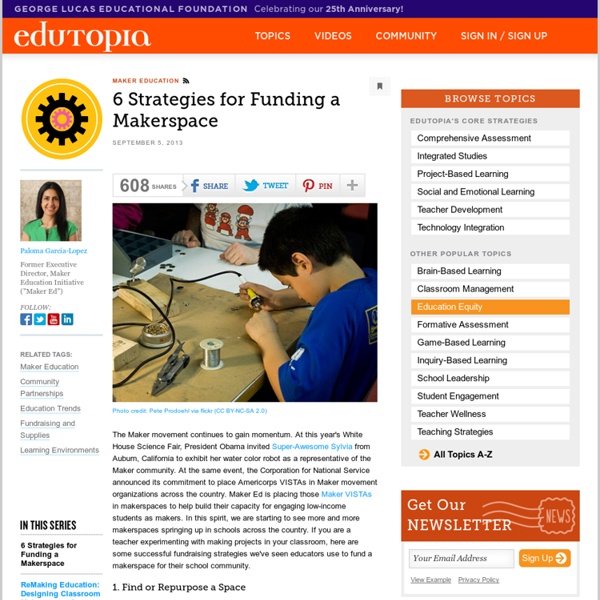Library as Incubator Project
hsmakerspacetoolsmaterials-201204.pdf
Designing a School Makerspace
Makerspaces, STEAM labs and fab labs are popping up in schools across the country. Makerspaces provide hands-on, creative ways to encourage students to design, experiment, build and invent as they deeply engage in science, engineering and tinkering. A makerspace is not solely a science lab, woodshop, computer lab or art room, but it may contain elements found in all of these familiar spaces. Therefore, it must be designed to accommodate a wide range of activities, tools and materials. Diversity and cross-pollination of activities are critical to the design, making and exploration process, and they are what set makerspaces and STEAM labs apart from single-use spaces. A possible range of activities might include: Cardboard construction Prototyping Woodworking Electronics Robotics Digital fabrication Building bicycles and kinetic machines Textiles and sewing Designing a space to accommodate such a wide range of activities is a challenging process. Ask the Right Questions Going Forward
Participatory Learning in Schools: Leadership and Policy
The use of mobile devices and social media in schools is critical for the creation of a participatory learning environment for children. In this environment, students are invited to collaborate, connect with peers and educators/adults inside and outside of the classroom, and integrate digital media for innovative thinking. We help school districts create a participatory learning environment through resources, best practices, and lessons learned in policy implementation. Today’s learning environment has dramatically changed with increasing ubiquitous access to technology and informal learning extending well beyond the classroom walls. With the support of the John D. and Catherine T. CoSN would like to thank the following sponsors for their support of this project: Blackboard, HP, and Lenovo. 7 Keys to Unlocking School Transformation with Digital Media Rethinking Acceptable Use Policies to Enable Digital Learning: A Guide for School Districts
How to Start a Makerspace When You're Broke
Everyone’s Favorite Excuse I’ve had the honor and privilege of sharing with hundreds of librarians and educators about our makerspace. Unfortunately, I see many educators hold back on starting a makerspace because of funds. I’m always hearing excuses like: “I’d love to do (insert cool Maker activity) at my school, but we don’t have a budget for that.” What many people don’t realize is that the idea that you need a lot of money to start a Makerspace is a myth. Share Your Vision with ALL THE PEOPLE You want to start a makerspace. Recycled materials can make for awesome projects Seek out Donations Never discount the value of donated materials. Consider putting out a bin for donations of recycled materials. We first started our makerspace with bins of K’nex found in a storage room Work with What You’ve Got Since you’ve started sharing your vision, you might have found out that your school already has some maker supplies lying around. Our Epic LEGO Wall was funded through DonorsChoose Like this:
Arduino + Chromebook
With over 5 Million units sold in 2014 alone, Chromebooks are a growing trend among schools and homes. One of the biggest drawbacks to Chromebooks has been the inability to connect it to any hardware (i.e. Arduino) -- until now. Favorited Favorite 2 Where EdTech meets TechEd With over 5 Million units sold in the past year, Chromebooks have been a growing trend among schools, homes, and small businesses. Many schools and school districts have been deploying tens of thousands of Chromebooks district-wide in 1:1 initiatives to get computing and technology into the classroom. In my experience, I’ve found that Chromebooks are amazing. Codebender + Chromebook The folks at codebender just released the codebender plug-in for Chromium OS / Chromebooks. A while back, we posted a short overview of alternatives to the standard Arduino IDE. This has been a big gap in what we have been able to do with Chromebooks. Click here for instructions for your browser plug-in. This is amazing! Give it a try!
School Makerspaces: Building the Buzz | Edutopia
If you build it, will they come? Just because you create a makerspace (PDF) in your school doesn't guarantee that your community will embrace it. Students who have had all personal choice removed by traditional educational models can be passive and feel overwhelmed when faced with real-world problems or design challenges. Academic passivity is common in schools where students swallow content and regurgitate it on multiple-choice tests. Students simply want to know how to get the "A." This type of learning does not stick. Teachers may find the role of facilitator (or "guide on the side") uncomfortable if they are used to being the "sage on the stage." How do you change your culture and ensure that your shiny new makerspace will empower students to acquire 21st-century skills? Engage Students Encourage and support student-centered work. Establish a culture of learning by doing. Start the first day with something simple like the Marshmallow Challenge. Support Educators "Occupy" the Space
Library Journal — Library News, Reviews, and Views
Expect the Miraculous | Barrow Media Center
A Librarian's Guide to Makerspaces: 16 Resources
"There were more than 135 million adult makers, more than half of the total adult population in America, in 2015." What is a makerspace? You’ve no doubt been hearing that word more than a few times over the past several years. Makerspaces, also called hackerspaces, hackspaces, and fablabs, are collaborative spaces where people gather to get creative with DIY projects, invent new ones, and share ideas. There were more than 135 million adult makers, more than half of the total adult population in America, in 2015. Articles & Blog Posts on Makerspaces 1.) 2.) 3.) 4.) 5.) 6.) 7.) 8.) 9.) 10. ) It all started with a training offered by the Washington State Library… Part of the “Between the Lines” series of the Washington State Library Blog, this post describes one library manager’s first encounter with STEM-based makerspace programming. 12.) Maker Faire Makerspaces Directories 1.) 2.) 3.) 4.) Revitalizing Community Spaces



